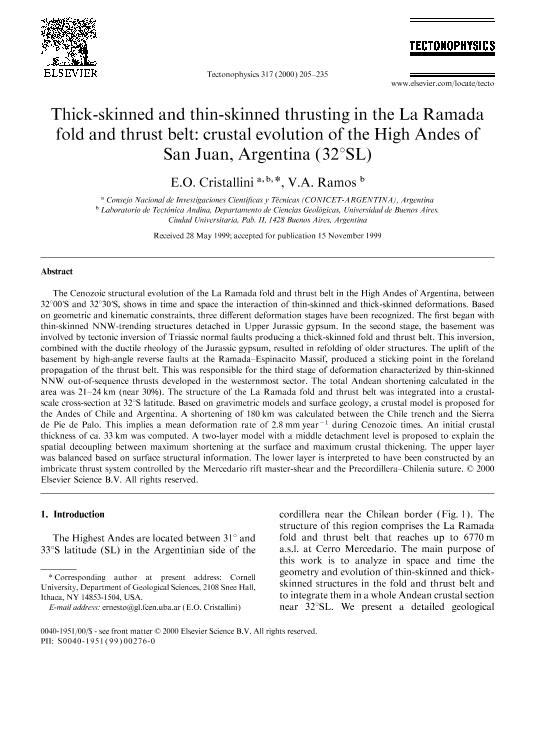Mostrar el registro sencillo del ítem
dc.contributor.author
Cristallini, Ernesto Osvaldo

dc.contributor.author
Ramos, Victor Alberto

dc.date.available
2020-01-06T20:49:57Z
dc.date.issued
2000-12
dc.identifier.citation
Cristallini, Ernesto Osvaldo; Ramos, Victor Alberto; Thick-skinned and thin-skinned thrusting in La Ramada fold and thrust belt : Crustal evolution of the High Andes of San Juan, Argentina (32° SL); Elsevier Science; Tectonophysics; 317; 3-4; 12-2000; 205-235
dc.identifier.issn
0040-1951
dc.identifier.uri
http://hdl.handle.net/11336/93722
dc.description.abstract
The Cenozoic structural evolution of the La Ramada fold and thrust belt in the High Andes of Argentina, between 32°00'S and 32°30'S, shows in time and space the interaction of thin-skinned and thick-skinned deformations. Based on geometric and kinematic constraints, three different deformation stages have been recognized. The first began with thin-skinned NNW-trending structures detached in Upper Jurassic gypsum. In the second stage, the basement was involved by tectonic inversion of Triassic normal faults producing a thick-skinned fold and thrust belt. This inversion, combined with the ductile rheology of the Jurassic gypsum, resulted in refolding of older structures. The uplift of the basement by high-angle reverse faults at the Ramada-Espinacito Massif, produced a sticking point in the foreland propagation of the thrust belt. This was responsible for the third stage of deformation characterized by thin-skinned NNW out-of-sequence thrusts developed in the westernmost sector. The total Andean shortening calculated in the area was 21-24 km (near 30%). The structure of the La Ramada fold and thrust belt was integrated into a crustal-scale cross-section at 32°S latitude. Based on gravimetric models and surface geology, a crustal model is proposed for the Andes of Chile and Argentina. A shortening of 180 km was calculated between the Chile trench and the Sierra de Pie de Palo. This implies a mean deformation rate of 2.8 mm year-1 during Cenozoic times. An initial crustal thickness of ca. 33 km was computed. A two-layer model with a middle detachment level is proposed to explain the spatial decoupling between maximum shortening at the surface and maximum crustal thickening. The upper layer was balanced based on surface structural information. The lower layer is interpreted to have been constructed by an imbricate thrust system controlled by the Mercedario rift master-shear and the Precordillera-Chilenia suture.
dc.format
application/pdf
dc.language.iso
eng
dc.publisher
Elsevier Science

dc.rights
info:eu-repo/semantics/openAccess
dc.rights.uri
https://creativecommons.org/licenses/by-nc-sa/2.5/ar/
dc.subject.classification
Geología

dc.subject.classification
Ciencias de la Tierra y relacionadas con el Medio Ambiente

dc.subject.classification
CIENCIAS NATURALES Y EXACTAS

dc.title
Thick-skinned and thin-skinned thrusting in La Ramada fold and thrust belt : Crustal evolution of the High Andes of San Juan, Argentina (32° SL)
dc.type
info:eu-repo/semantics/article
dc.type
info:ar-repo/semantics/artículo
dc.type
info:eu-repo/semantics/publishedVersion
dc.date.updated
2019-12-12T14:52:51Z
dc.journal.volume
317
dc.journal.number
3-4
dc.journal.pagination
205-235
dc.journal.pais
Países Bajos

dc.journal.ciudad
Amsterdam
dc.description.fil
Fil: Cristallini, Ernesto Osvaldo. Consejo Nacional de Investigaciones Científicas y Técnicas. Oficina de Coordinación Administrativa Ciudad Universitaria. Instituto de Estudios Andinos "Don Pablo Groeber". Universidad de Buenos Aires. Facultad de Ciencias Exactas y Naturales. Instituto de Estudios Andinos "Don Pablo Groeber"; Argentina
dc.description.fil
Fil: Ramos, Victor Alberto. Consejo Nacional de Investigaciones Científicas y Técnicas. Oficina de Coordinación Administrativa Ciudad Universitaria. Instituto de Estudios Andinos "Don Pablo Groeber". Universidad de Buenos Aires. Facultad de Ciencias Exactas y Naturales. Instituto de Estudios Andinos "Don Pablo Groeber"; Argentina
dc.journal.title
Tectonophysics

dc.relation.alternativeid
info:eu-repo/semantics/altIdentifier/url/https://www.sciencedirect.com/science/article/pii/S0040195199002760
dc.relation.alternativeid
info:eu-repo/semantics/altIdentifier/doi/https://doi.org/10.1016/S0040-1951(99)00276-0
Archivos asociados
